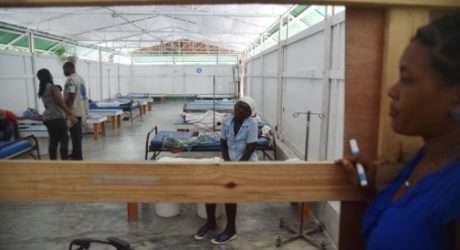Plastic-sheeted cots for men, women and children are crammed side by side in a former hangar. At the cholera treatment center in the Haitian city of Carrefour, the sick have no privacy.
Djelile Pierre gingerly uses a syringe to feed her five-year-old daughter, who has been hospitalized there near the capital of Port-au-Prince for three days.
“I didn’t think she was going to survive,” said the 24-year-old mother. “She’s still very weak and refuses to eat anything.”
Whether from drinking unsafe, untreated water or eating contaminated food, the little girl contracted cholera, falling to the same fate as nearly 800,000 Haitians since the epidemic broke out in October 2010 near a base housing UN peacekeepers.
Earlier this month, the United Nations finally admitted for the first time that it had played a role in the epidemic that has killed 10,000 people in the poorest country in the Americas.
UN peacekeepers from Nepal, which was suffering a cholera outbreak, introduced the disease to the impoverished Caribbean nation, the UN acknowledged, while insisting the world body is legally immune to lawsuits.
But on the ground in Haiti, medical teams are worried about the lack of funding.
“After October, no one knows how to continue supporting a rapid response,” said Jean Ludovic Metenier, deputy representative of the United Nations Children’s Fund (UNICEF) in Haiti.
The acute diarrheal disease can kill within hours if left untreated. Already, humanitarian organizations intervene only to prevent the spread of cholera, on a case-by-case basis.
About 60 kilometers (35 miles) north of the capital, patients arriving at the hospital in Verrettes with acute diarrhea are interviewed by personnel from a French non-governmental organization, the Agency for Technical Cooperation and Development (ACTED), to determine how they contracted the disease.
While reassuring relatives of a hospitalized youth, a team headed to their small home to cover its dirt walls with a chlorine solution one morning.
“We are decontaminating the home of the patient and the toilets to kill the (cholera) bacteria to prevent the people sharing the facilities from being infected,” said ACTED’s Nadine Guerrier.
In the tiny, rural village, the sanitation operation does not go unnoticed, and the humanitarian workers explain to the curious the hygiene guidelines for avoiding cholera.
This urgent awareness campaign is currently the only action being taken to fight the epidemic.
– Deplorable conditions –
“People have completely stopped working on health sanitation and potable water infrastructure,” said Emilie Bernard, country director for ACTED Haiti. “So we are only putting a bandage on an open fracture.”
Six years after the start of the epidemic, about 72 percent of Haitians have no toilets at home and 42 percent lack access to safe drinking water, according to the UN.
The situation is dire, with 500 new cases of cholera reported each week and Haiti facing its worst epidemic in recent history.
“Since the beginning of the year, there have been 25,000 cases in the country,” Metenier said.
“In the Democratic Republic of Congo, a country with 10 times as many inhabitants, there were only 15,000 cases since January,” he said.
The teams battling the epidemic are dismayed that the troubling Haitian sanitary crisis has not drawn more attention from the international community.
“Cholera can be eliminated if one has the means,” Metenier emphasized.
“Ebola, which had roughly the same number of fatalities, mobilized $1.5 billion. The cholera epidemic in Haiti since 2010 has only drawn $300 million.”
On the ground, the lack of money has terrible repercussions.
“We receive treatments to care for 10 patients a day,” said Mirlene Lorcy, supervisor at the treatment center in Carrefour.
But by mid-morning one day, 12 patients were already on beds in the hangar.
“We take care of all the sick who come on their own, but if they arrive by ambulance, we send them somewhere else,” she said.
Lorcy said she was not sure where the sick were transported. But she noted that the Carrefour facility, due to a lack of money, has cut its staff in half since July.
In early August, French epidemiologist Renaud Piarroux reported more than 21,000 cholera cases and 200 deaths occurred from January to June.
He predicted that with the rainy season lasting through November or even into December, cholera could “easily” kill up to 500 people this year, 200 more than died two years ago.














